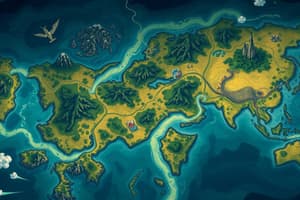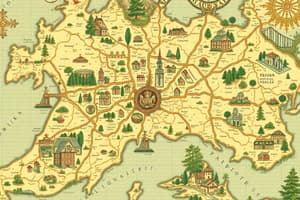Podcast
Questions and Answers
What is cartography?
What is cartography?
Cartography is the set of operations aimed at the design, production, and use of maps. It is a science that allows us to graphically model geographic space.
Which of the following is NOT a purpose of cartography?
Which of the following is NOT a purpose of cartography?
- Create and sell maps to the general public. (correct)
- Communicate geographical, political, economic, social, and natural information.
- Aid in decision-making in various fields.
- Represent geographic space on a flat surface.
What are the earliest known maps?
What are the earliest known maps?
The earliest known maps are considered to be the Babylonian map, dating back to 600 BC.
What do topographic maps primarily depict?
What do topographic maps primarily depict?
What kind of information do thematic maps represent?
What kind of information do thematic maps represent?
Road maps are primarily used for navigation, but can also be helpful for trip planning.
Road maps are primarily used for navigation, but can also be helpful for trip planning.
What is the purpose of cadastral maps?
What is the purpose of cadastral maps?
What is the primary function of nautical and aeronautical charts?
What is the primary function of nautical and aeronautical charts?
What is the definition of a map's scale?
What is the definition of a map's scale?
What is the purpose of a map's legend?
What is the purpose of a map's legend?
What is the primary purpose of a map's orientation?
What is the primary purpose of a map's orientation?
What is the role of contour lines on topographic maps?
What is the role of contour lines on topographic maps?
What are the main sources of data used for creating modern maps?
What are the main sources of data used for creating modern maps?
Cartographic generalization is the process of simplifying information on a map for better readability.
Cartographic generalization is the process of simplifying information on a map for better readability.
What is the purpose of map projections?
What is the purpose of map projections?
Which of the following map projections is known for its distinctive distortion at the poles?
Which of the following map projections is known for its distinctive distortion at the poles?
Graphic design plays a vital role in map-making, ensuring readability and effectiveness.
Graphic design plays a vital role in map-making, ensuring readability and effectiveness.
Which of these is NOT a critical step in ensuring the accuracy of maps?
Which of these is NOT a critical step in ensuring the accuracy of maps?
What is the significance of maps in education?
What is the significance of maps in education?
Maps are not necessarily useful in urban planning.
Maps are not necessarily useful in urban planning.
How do maps contribute to agricultural management?
How do maps contribute to agricultural management?
What is the primary purpose of maps in maritime and air navigation?
What is the primary purpose of maps in maritime and air navigation?
How do maps help scientists study climate change?
How do maps help scientists study climate change?
Maps are not particularly useful in studying economic and social trends.
Maps are not particularly useful in studying economic and social trends.
What is the impact of 'big data' on modern cartography?
What is the impact of 'big data' on modern cartography?
Interactive digital cartography is becoming increasingly common in modern mapmaking.
Interactive digital cartography is becoming increasingly common in modern mapmaking.
What is the primary function of real-time maps?
What is the primary function of real-time maps?
Explain the importance of cartography in managing global challenges such as climate change, urban growth, and ecosystem conservation.
Explain the importance of cartography in managing global challenges such as climate change, urban growth, and ecosystem conservation.
Flashcards
What is cartography?
What is cartography?
The science of creating, designing, and using maps to visually represent geographic space.
What is a map projection?
What is a map projection?
To represent the Earth's curved surface on a flat map, different projections are used. They distort some aspects, like size or shape.
What is map scale?
What is map scale?
The ratio between a distance on the map and the corresponding real-world distance. A large scale shows more detail in a smaller area, while a small scale shows a larger region with less detail.
What are thematic maps?
What are thematic maps?
Signup and view all the flashcards
What are cadastral maps?
What are cadastral maps?
Signup and view all the flashcards
What are topographic maps?
What are topographic maps?
Signup and view all the flashcards
What are contour lines?
What are contour lines?
Signup and view all the flashcards
How is geographic data collected for maps?
How is geographic data collected for maps?
Signup and view all the flashcards
What is cartographic generalization?
What is cartographic generalization?
Signup and view all the flashcards
What is a map legend?
What is a map legend?
Signup and view all the flashcards
What is cartographic simplification?
What is cartographic simplification?
Signup and view all the flashcards
What are nautical and aeronautical charts?
What are nautical and aeronautical charts?
Signup and view all the flashcards
What are road maps?
What are road maps?
Signup and view all the flashcards
What is a map legend?
What is a map legend?
Signup and view all the flashcards
What is a map's orientation?
What is a map's orientation?
Signup and view all the flashcards
Study Notes
Cartography: Introduction
- Cartography is the design, production, and use of maps.
- It's a science that models geographic space graphically.
Purpose of Cartography
- Represents geographic space on a flat surface.
- Communicates various types of information (geographic, political, economic, social, natural).
- Aids decision-making in fields like urban planning and resource management.
History of Cartography
- Earliest known map: Babylonian map (600 BC).
- Middle Ages: Development of T-O maps and portolan charts.
- Age of Exploration and modern times: Topographic and thematic maps became more common.
Types of Maps
Topographic Maps
- Represent natural and man-made features (mountains, rivers, roads, buildings.)
- Key elements include contour lines, symbols, and elevation marks.
- Used for hiking, urban planning, and land management.
Thematic Maps
- Represent specific information such as climate, population, or vegetation.
- Use colors and symbols specific to the theme
- Used for sociological, climatological, and demographic analyses.
Road Maps
- Display roads, highways, and transportation routes.
- Key elements include roads, cities, points of interest.
- Used for trip planning and logistics.
Cadastral Maps
- Show division of land into parcels.
- Key elements include property boundaries, parcel identification, and buildings.
- Used for land management, taxation, and urban planning.
Nautical and Aeronautical Charts
- Used for navigation (maritime and aerial).
- Show depth indicators, buoys, maritime and air routes.
- Used for safe navigation.
Map Elements
Scale
- Ratio between map distance and actual distance.
- Large scale (1:10,000) for detailed maps
- Small scale (1:1,000,000) for large region maps.
Legend
- Explains map symbols.
- Examples include symbols for roads, forests, rivers, cities, and boundaries.
Orientation
- Usually indicated by an arrow or a compass rose showing north.
- The Greenwich Meridian is a reference point for longitudes.
Contour Lines
- Lines connect points of equal altitude on a topographic map.
- Used to represent relief features (mountains, valleys).
Map Creation
- Data sources include satellites, GPS, and topographic surveys.
- Cartographic generalization: Simplifying information for better readability.
- Map projections: Methods to represent a curved Earth on a flat map (various types exist).
- Graphic design: Choosing colors, symbols, and layout for readability.
- Verification and updating maps for accuracy and relevance.
Use of Maps in Various Fields
- Education: Essential tool for teaching geography, history, and environmental science.
- Planning and Management: Used for urban planning, agriculture and managing resources.
- Navigation: Used for maritime, and air navigation.
- Scientific Analysis: Used in environmental studies, to monitor climate change and ecological changes.
Modern Challenges in Cartography
- Big Data and Cartography: Impact of large amounts of spatial data on map creation.
- Interactive and Digital Cartography: The use of GIS (Geographic Information Systems) and applications for interactive maps.
- Real-time Maps: Development of real-time maps for navigation and emergency management.
Studying That Suits You
Use AI to generate personalized quizzes and flashcards to suit your learning preferences.




